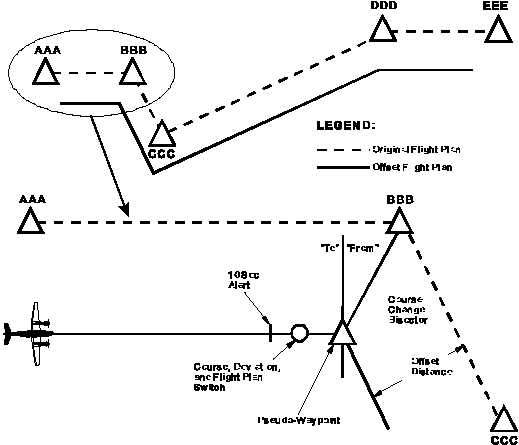TM 1-1510-225-10
3B-82
g. Parallel Course Offsets.
NOTE
Offsets may be defined to the left or right
or the original course. Once applied they
remain in effect for the remainder of the
flight plan unless canceled.
(1) Parallel Course Offset Geometry. A
parallel course offset may be applied to the flight plan
for weather or traffic avoidance or when assigned by
Air Traffic Control (ATC). When an offset is applied,
all displays keyed to the active waypoint (e.g., time
and distance to go, TO / FROM flag) become
referenced to the pseudo-waypoint at the intersection
of the course change bisector and the offset course.
The leg switch point and the associated 10-second
alert are computed relative to the pseudo-waypoint.
Crosstrack deviation is computed relative to the offset
course. Figure 3B -45 shows the geometry associated
with waypoint switching when a parallel offset is
applied.
NOTE
Executing Direct-To a waypoint will cancel
a parallel course offset if one has been
applied.
(2) Parallel Offset Initiation, Termination, Or
Change. Parallel course offsets may be applied,
changed, or deleted any time the active waypoint is
not identified as a pattern or an approach waypoint.
Refer to Figure 3B-46 and Table 3B -36 for an
illustration of application and deletion of parallel course
offset. If the waypoint identified as a pattern or an
approach waypoint fix becomes the active waypoint or
FLYOVER sequencing is selected while an offset is
defined, the offset is automatically canceled and the
aircraft will capture the original flight plan course. If a
pattern or approach is applied to an active waypoint
with an offset applied, the offset is automatically
canceled.
Initiation
of
the
Direct-To
function
automatically cancels the parallel offset. Refer to
Figure 3B-47.
An OFST a nnunciation on the Horizontal
Situation Indicator (HSI) or external OFFSET capsule
light annunciation is activated whenever an offset is
action.
Figure 3B-45. Parallel Course Offset Geometry


